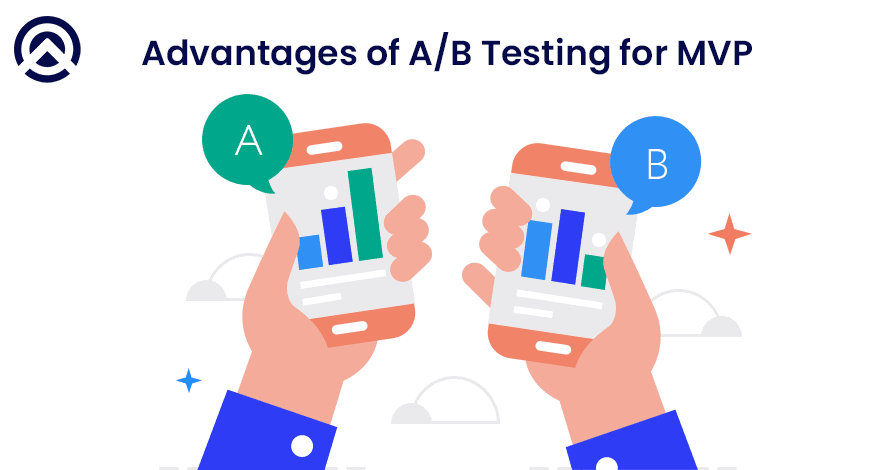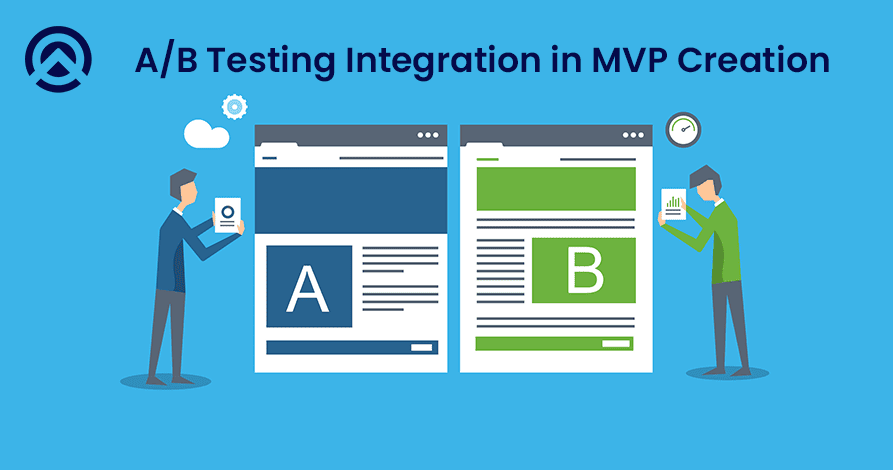A/B Testing for MVP: Making Data-Driven Decisions for Success
Imagine this, you have poured your heart and mind into an innovative project idea. In which you brainstormed, finalized designs, and developed them with the Minimum Viable Product (MVP) approach. And you also think that this project can potentially reform the market standards. But here comes a situation in which you are required to think smartly to present this highly potential idea within a competitive market. As a solution, we can only suggest you opt for A/B testing of the MVP outcome.
In this era of rapidly growing MVP development services. A/B testing is the best possible solution for market recognition or a marketing approach for evaluating the efficiency of a web-based product. This method is also recognized as split testing which uses data for analyzing any change which is appropriate or not from the beneficial aspect. The integration of this marketing approach for MVP products can lead to different benefits. These are efficient decision-making based on data insights, optimized user experience, customer-centric improvements, reduction of market failure risks, increment in conversion rates, implementation of continuous improvements, and competitive advantage.
In this blog, we embark on a journey through the intricate domain of A/B testing, where tech meets strategy to enhance the potential of MVP. We’ll delve deep into the inner workings of A/B testing, exploring its technical intricacies, from hypothesis formulation to statistical significance, while deciphering how it empowers developers to optimize their creations. Whether you’re a seasoned tech entrepreneur, a software engineer pushing the boundaries of innovation, or a data-driven product manager, prepare to delve into the captivating world of A/B testing for MVPs. Together, we’ll explore how harnessing data and technology can elevate your MVP to the next level of product excellence.
Advantages of A/B Testing for MVP and its Data-Driven Decision-Making

Effective marketing is an essential term for the establishment of a new product within the market standards. In this context, A/B testing is the term that can provide different advantages that can lead to the effective progress of the MVP products. These advantages are explained further.
1. Understanding the User in a Better Way
A/B testing provides a detailed view of user behavior and preferences. By analyzing user interactions with different variations, you can uncover valuable insights into what drives engagement and what leads to abandonment. This understanding goes beyond surface-level observations, allowing you to identify subtleties in user behavior that might have been missed otherwise.
2. Iterative Refinement
MVPs are essentially prototypes, and A/B testing is your toolkit for fine-tuning them. It allows for incremental changes based on user feedback and data analysis. This iterative approach ensures that your MVP evolves in response to user needs and market dynamics, increasing its chances of becoming a successful final product.
3. Empirical Insights
A/B testing is the antithesis of guesswork. It relies on empirical data and statistical rigor. This scientific approach ensures that your decisions are based on real-world evidence, reducing the risk of making misguided choices. The data generated by A/B tests also offers a clear basis for discussions with stakeholders, making it easier to convey the rationale behind your decisions.
4. Well-optimized User Experience
A/B testing is not just about identifying what works, it is also about uncovering what doesn’t. By comparing variations, you can pinpoint aspects of your MVP that may be causing friction or confusion for users. With this insight, you can prioritize improvements that enhance the overall user experience, making your product more user-friendly and appealing.
5. Risk Mitigation
Launching a new product, even an MVP, carries inherent risks, including financial and reputational. A/B testing acts as a risk mitigator by allowing you to validate assumptions before scaling up. By catching potential pitfalls early in the software development process, you can avoid costly mistakes and pivot in a direction that is more likely to succeed.
6. Continuous Improvement
A/B testing is a commitment to ongoing enhancement. It’s not a one-and-done exercise; it’s a strategy for continual progress. As you gather more data and insights, you can make continuous improvements to your MVP, ensuring that it remains competitive and aligned with evolving user expectations.
7. Resource Efficiency
In resource-constrained environments, making the most of every resource is crucial. A/B testing helps you allocate time, money, and effort where they will have the greatest impact. By focusing on strategies or features that have demonstrated effectiveness, you can optimize resource utilization and maximize the return on investment.
8. Assured Conversions
MVPs have specific conversion goals, such as encouraging sign-ups or purchases, A/B testing can lead to significant performance improvements. By identifying the most persuasive strategies and optimizing conversion funnels, you can boost conversion rates, ultimately driving revenue and growth.
9. Product Customization & personalization
A/B testing allows you to tailor the user experience based on individual preferences, creating a more personalized journey for each user. Personalization can lead to higher user satisfaction and retention rates, as users feel that the product caters specifically to their needs and preferences.
10. Competitive Advantage
A/B testing gives you a competitive edge by enabling you to outpace competitors who rely on intuition or guesswork. Your ability to make data-driven decisions positions your MVP as a more agile and adaptable product, better equipped to respond to changing market conditions and user preferences.
11. Quantifiable Results
The A/B testing results are not vague or subjective. They are quantifiable, providing clear metrics that measure the impact of changes. These quantifiable results are crucial for tracking progress, demonstrating the ROI of your efforts, and making data-driven arguments when discussing product decisions with stakeholders.
12. Gross work Reduction
A/B testing replaces subjective judgments with objective evidence. Instead of relying on hunches or opinions, you can systematically evaluate the performance of different product elements. This reduction in guesswork can lead to more confident and effective decision-making, as you can trust that your choices are supported by data.
Also Read: How to Ensure Test Coverage in Software Testing
Incorporating A/B Testing into MVP Development

MVP app development is considered the best practice for a newcomer in the software development market. And when it comes to adding more accuracy within the marketing process A/B testing is mostly suggested. With the follow-up of these further mentioned steps proper A/B testing can be conducted for MVP products.
1. Defining Clear Objectives
Incorporating A/B testing into MVP product development necessitates a methodical approach to establishing precise and measurable objectives for each A/B test. These objectives serve as a guiding framework, ensuring that the tests are closely aligned with the overarching goals of your MVP. To begin, identify the specific aspect of your MVP that requires enhancement, whether it pertains to user engagement, conversion rates, or user retention.
Next, define clear and specific objectives for the A/B test, such as determining which version of a feature or interface drives higher engagement or finding the most effective strategies for increasing sign-ups or purchases. Additionally, make certain that these objectives are quantifiable by specifying key performance indicators (KPIs) that correlate with your aims. For instance, metrics like click-through rates (CTR) or time spent on the MVP may be relevant depending on your objectives.
It’s also beneficial to formulate a hypothesis explaining why you anticipate the changes being tested will achieve the desired outcome. Documenting these objectives comprehensively, alongside ensuring they align with the overarching MVP goals, is essential. These documented objectives provide a robust foundation for data-driven decision-making throughout the A/B testing process, ultimately contributing to the success of your MVP.
Also Read: The Blueprint for Building Engaging and Secure Social Apps
2. Identification of Key Metrics
After the establishment of clear objectives for your A/B tests, the next crucial step involves identifying the key performance indicators (KPIs) that directly align with those objectives. KPIs serve as precise metrics that provide a quantitative measure of the success or impact of your A/B tests. The choice of KPIs should be driven by the specific objectives you’ve set and the unique characteristics of your MVP. Commonly utilized KPIs include CTR, which gauges user engagement and interaction, particularly useful if your aim is to enhance these aspects.
Bounce Rates come into focus when user retention is a priority, with lower bounce rates indicating that your changes are potentially reducing immediate exits from your MVP. For MVPs with a revenue-oriented focus, tracking Revenue per User is essential to assess the financial implications of your A/B tests. Lastly, if your objective centers around increasing conversions, closely monitoring Conversion Rates is pivotal in determining the success of your experimental strategies. Careful selection of KPIs ensures that you’re precisely measuring the outcomes that hold the greatest significance in propelling your MVP toward success.
3. Formation of Hypothesis and Testing
With clear objectives and identified KPIs in place, it’s time to formulate hypotheses. Hypotheses are educated guesses about what changes or variations could improve your MVP. These hypotheses guide your A/B tests. For example, if the objective is to increase user engagement, your hypothesis might be CTA button color from red to green will lead to higher engagement. It’s essential to ensure that your hypotheses are specific, testable, and aligned with your objectives. After formulating hypotheses, design your A/B tests to rigorously compare variations. This involves creating two (or more) versions of the element or feature you’re testing (A and B) and then randomly assigning users to these groups.
Read more: A Step-by-Step Guide: Crafting the Perfect MVP for Your SaaS Startup
4. The process of Analyse and Iterative
The major work of A/B testing lies in the analysis of data and the iterative process that follows. Once your A/B test has run for a sufficient duration to gather meaningful data, it’s time to analyze the results. Carefully examine the performance of each variation in terms of your chosen KPIs. Use statistical methods to determine if one variation significantly outperforms the other. Based on your analysis, make informed decisions. If one variation proves to be more effective, implement it in your MVP. If the results are inconclusive, consider running additional tests with adjusted variations. Remember that A/B testing is an ongoing process. As you iterate on your MVP and gather more user data, continue to refine and optimize based on your learnings.
Conclusion
A/B Testing for MVPs plays a pivotal role in making data-driven decisions to ensure product success. These tests offer tailored insights for various product scenarios. With the increasing need for evidence-based development and optimization, the tech industry has seen visionary developers and forward-thinking organizations working to enhance their products through empirical analysis. Despite initial challenges, many have become pioneers in A/B testing methodologies. In today’s ever-evolving landscape of digital products, the adoption of smart data-driven strategies is more accessible, allowing companies to adapt to modern market demands.
Amplework, the best mobile app development services provider with over 5+ years of experience, excels in this field. Our dedicated team consistently surpasses client expectations, earning a reputation for reliability. We’ve achieved significant milestones of generating more than 200 million in revenue by supporting various organizations. Explore our website to discover our exceptional services for MVPs. Partner with Amplework to embark on a transformative journey toward making data-driven decisions that lead to product success and ultimately improve your product’s quality and user satisfaction.


 sales@amplework.com
sales@amplework.com
 (+91) 9636-962-228
(+91) 9636-962-228





